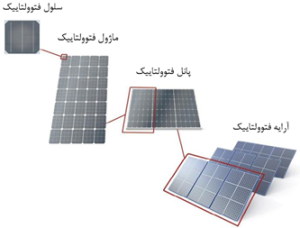Solar System Technology

- news
- 0
Photovoltaic systems technology
The main element of solar technology is the solar cell. Solar cells (PV), commonly known as solar cells, are composed of solid state semiconductor materials. Silicon is the most common semiconductor material used in PV cells due to its abundance. Although silicon is an abundant element and makes up a large percentage of the earth’s crust, silicon cells have a high price due to the process of making and purifying silicon.
A solar cell converts sunlight directly into electrical energy. The basic principle in this technology is the “photoelectric” phenomenon, which was first proposed by Einstein. “Photo” means light and “voltaic” means electricity.

Solar cells, like transistors, are usually made of thin layers of a semiconductor material such as silicon with small amounts of special additives to create an excess of electrons in one layer and a deficiency of electrons in the other. Photons of light create free electrons in a layer, and a conductive string enables electrons to flow in an external circuit and access layers that lack electrons.
Types of photovoltaic systems
Solar systems for public and agricultural purposes are used as power plants independent of the national grid or systems connected to the national grid with a fixed or mobile installation structure in small units with low power to supply the electrical energy required from small calculators to large power plant systems. . There are two main types of solar PV (PV) systems for use in buildings:
- Solitary
- connected to the network
Solitary
In many cases, such as remote villages or areas far from the national electricity grid, connecting to the grid is not possible or requires spending heavy expenses for the transmission and use of electricity, these expenses can include the installation of electric poles, the purchase of concessions, and the installation of electricity meters or the like. cases. In such cases, it is better to use isolated or isolated systems.

Individual systems consist of the following main components:
- Solar panels
- Charge controller
- battery
- DC to AC power converter (inverter)
In individual systems of the grid, the number of installed panels should be selected based on the intended consumption and the electricity produced by the solar panels is stored in batteries for use throughout the day and night. In these systems, several storages (batteries) are needed to provide electricity at night or on cloudy days and when the maximum amount of electricity is needed. The size of the PV arrays is adjusted to handle both the daily loads and the charging of the batteries.
Individual systems no longer need to be connected to the power grid, and no cost will be paid for purchasing points and transferring power lines, but due to the use of batteries, the costs of the basic equipment of individual systems will be slightly higher than those connected to the network.
connected to the network
Unlike the individual mode, solar systems connected to the grid also use the national electricity grid.

In a system connected to the grid, a converter is needed to change the direct current from the PV array to alternating current (AC) with the appropriate grid voltage. It should be noted that in this case, there is no need for storage or batteries, and in this way, significant savings will be made in both the cost and the maintenance of the system.
Components of photovoltaic systems
The main components of a radiation system are:
- Solar panels
- Storage batteries
- Direct to alternating current converter
- Metal structure or building
Solar Panels
The most important part of any solar system is solar panels. Solar panels are a number of modules that are connected together and arrays are created from the assembly of panels. Solar arrays are generally connected in series or parallel. These arrays are installed in a fixed mode or a moving tracker that adapts to the sun’s radiation angle according to the season.

battery
The battery bank is usually 12 volts and includes a number of batteries and is connected in series and provides the required voltage of the system. In off-grid systems, the energy stored in the batteries is used at night or other times of need. Batteries are used in support systems when the national grid is out, systems connected to the grid do not need batteries.
converter (inverter)
The electricity produced by solar panels is DC and is converted into AC electricity with the help of converters. Converters are made in different types and sizes and some of them have very high efficiency.

Support structure
They are one of the main components of solar systems and support the module in a specific direction and angle towards the sunlight. Building structures are made of metal or synthetic materials resistant to factors such as wind and rain. Building structures are designed and selected according to the location of solar systems.
Support structures can be equipped with solar trackers. Trackers have different types and can rotate or move in different directions considering the need. The trackers always keep the solar panels in the direction of the sun’s rays, thus increasing the output efficiency of the panels up to 2 times.
Although the use of detectors will increase efficiency, it will also result in more installation and maintenance costs. Therefore, the profitability of using a solar tracker should be checked in different situations and used only in appropriate cases.


